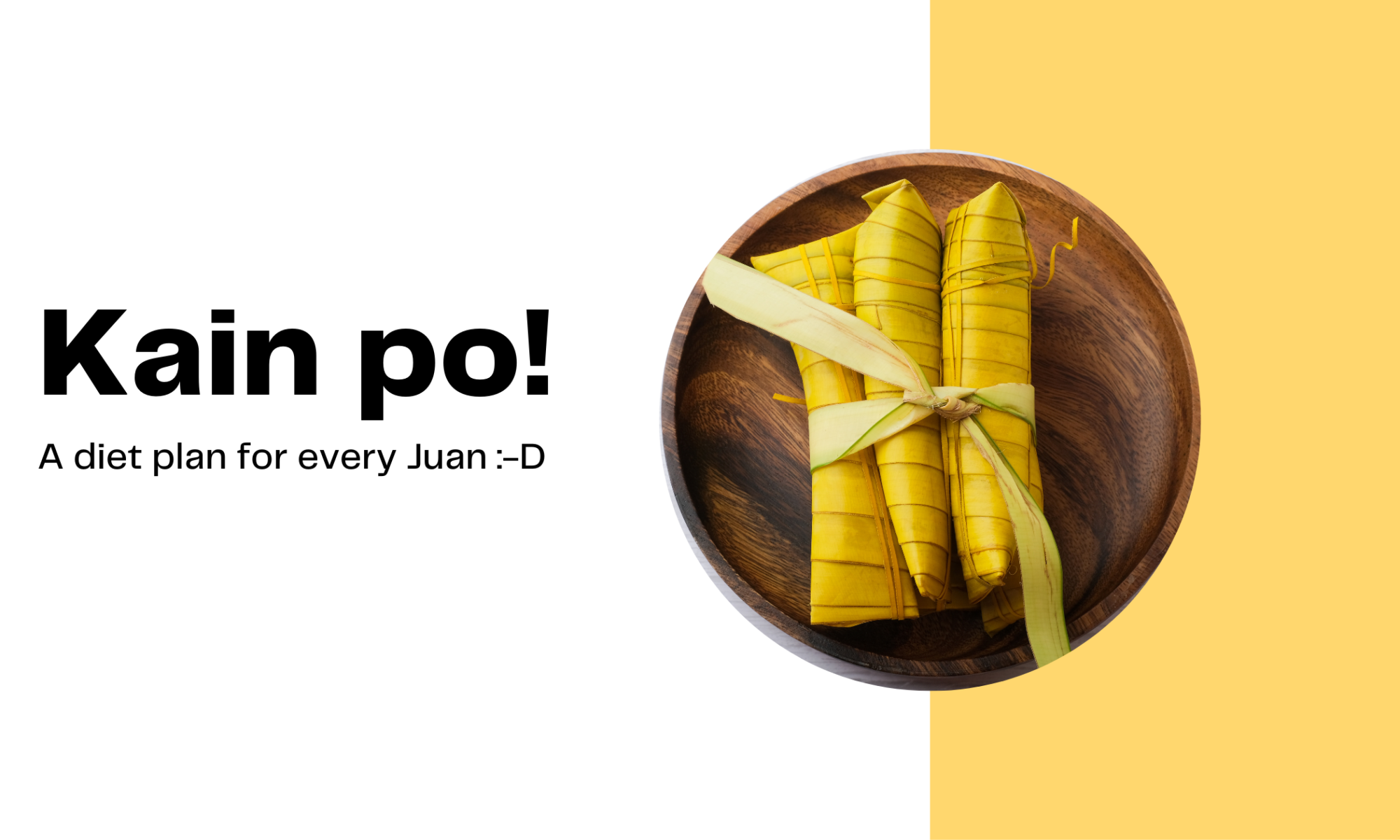A Library of Diet Plans
Pick a sample meal plan that fits you and click the photo for more nutrition tips:
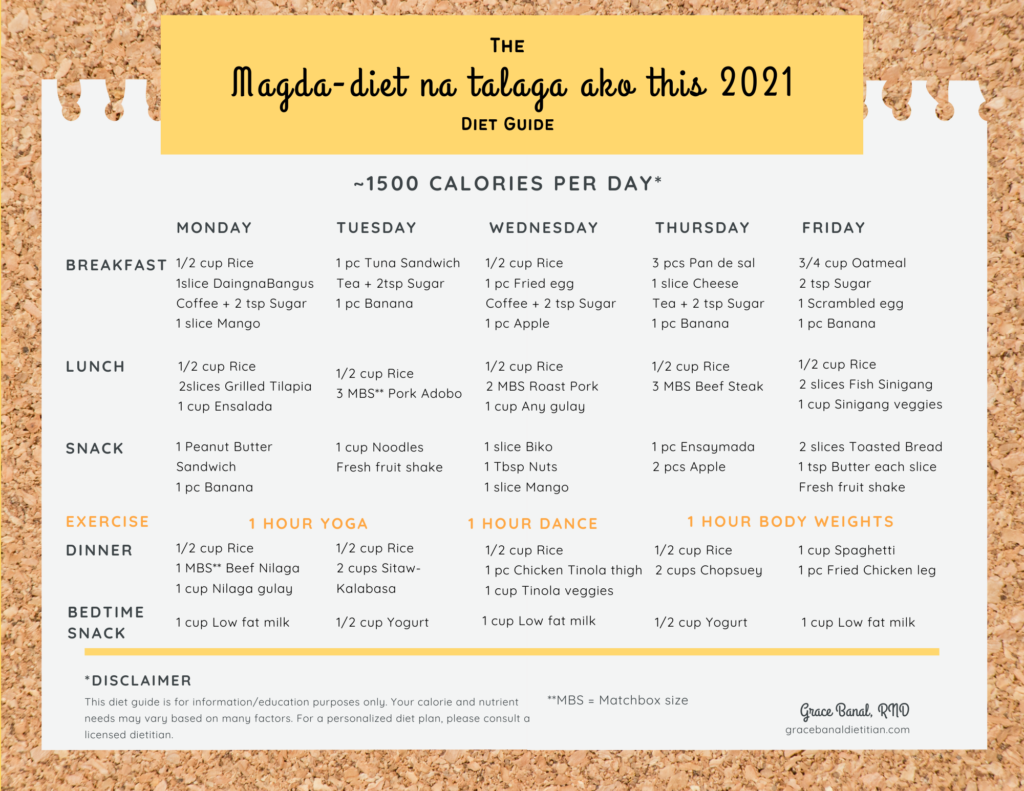
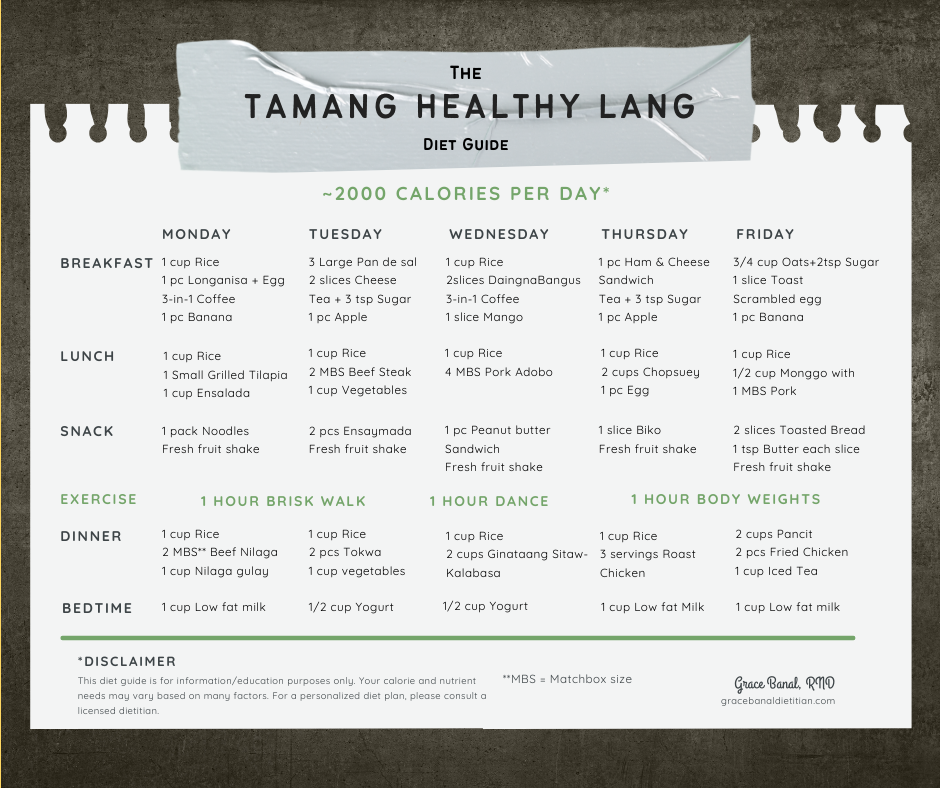
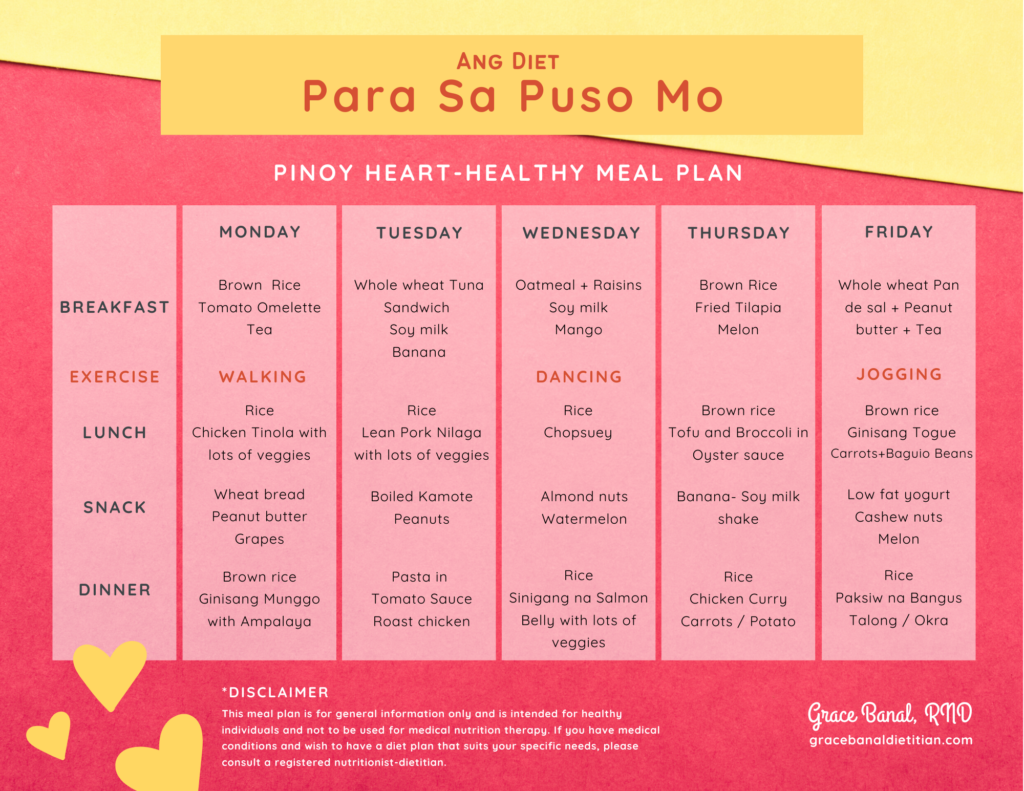

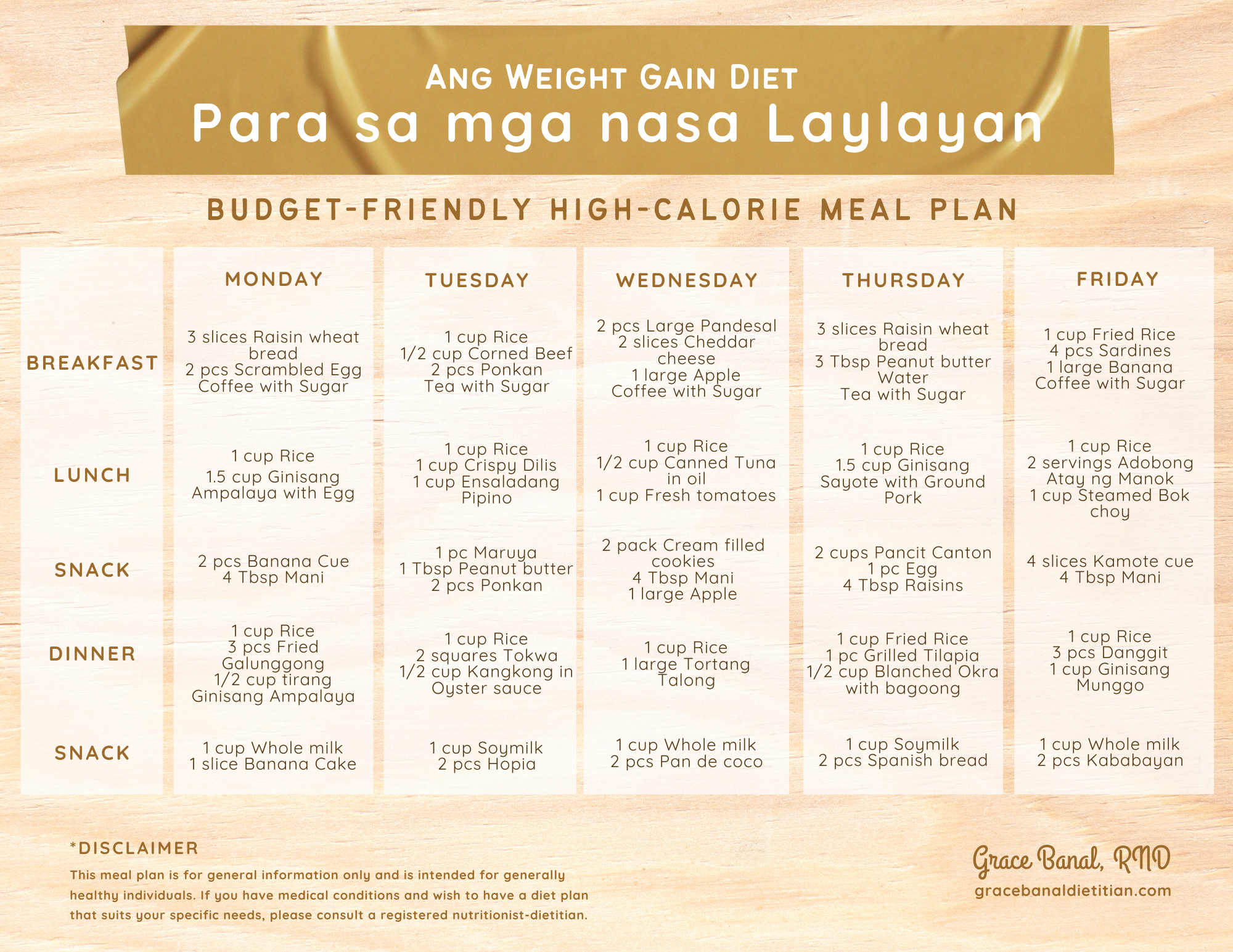
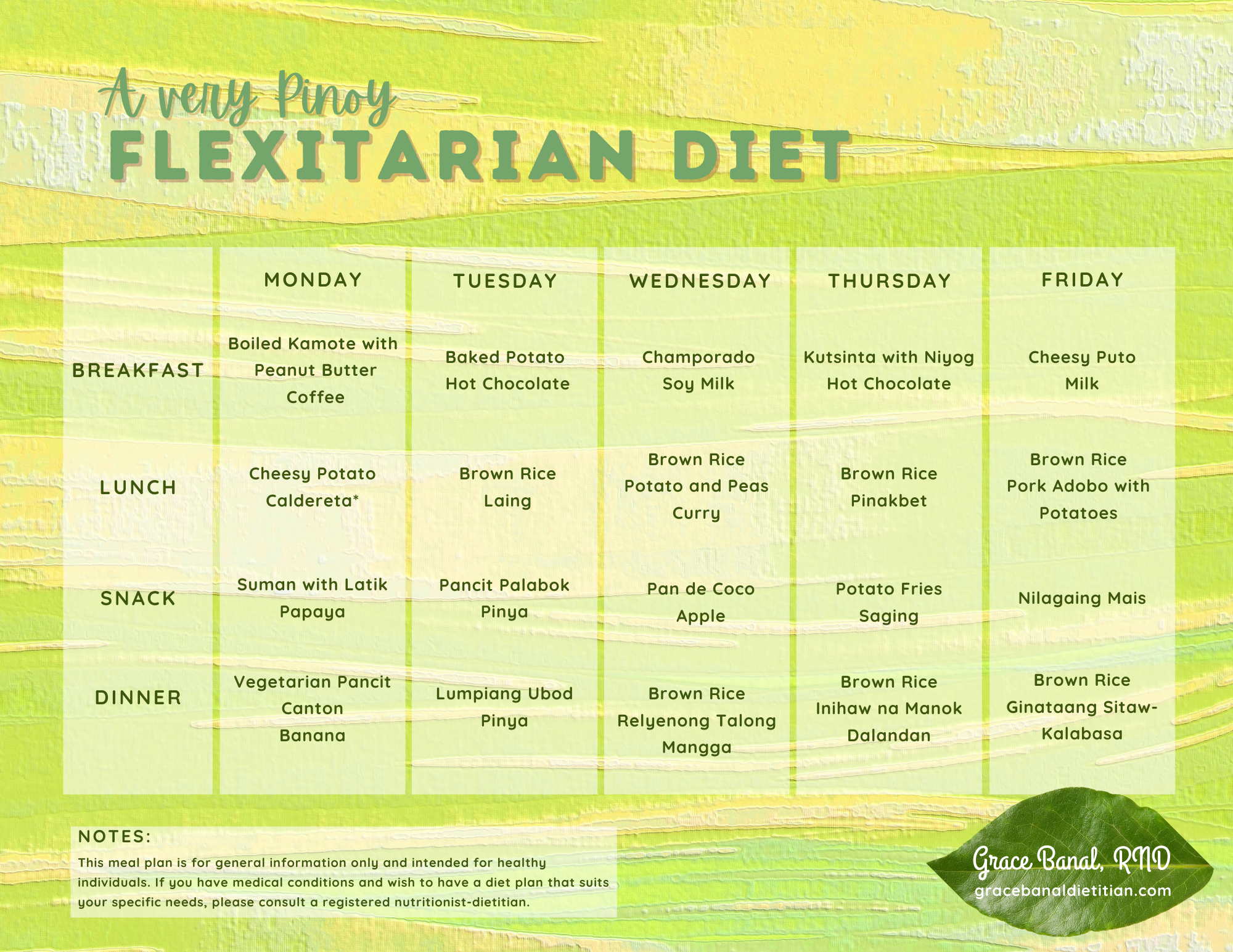
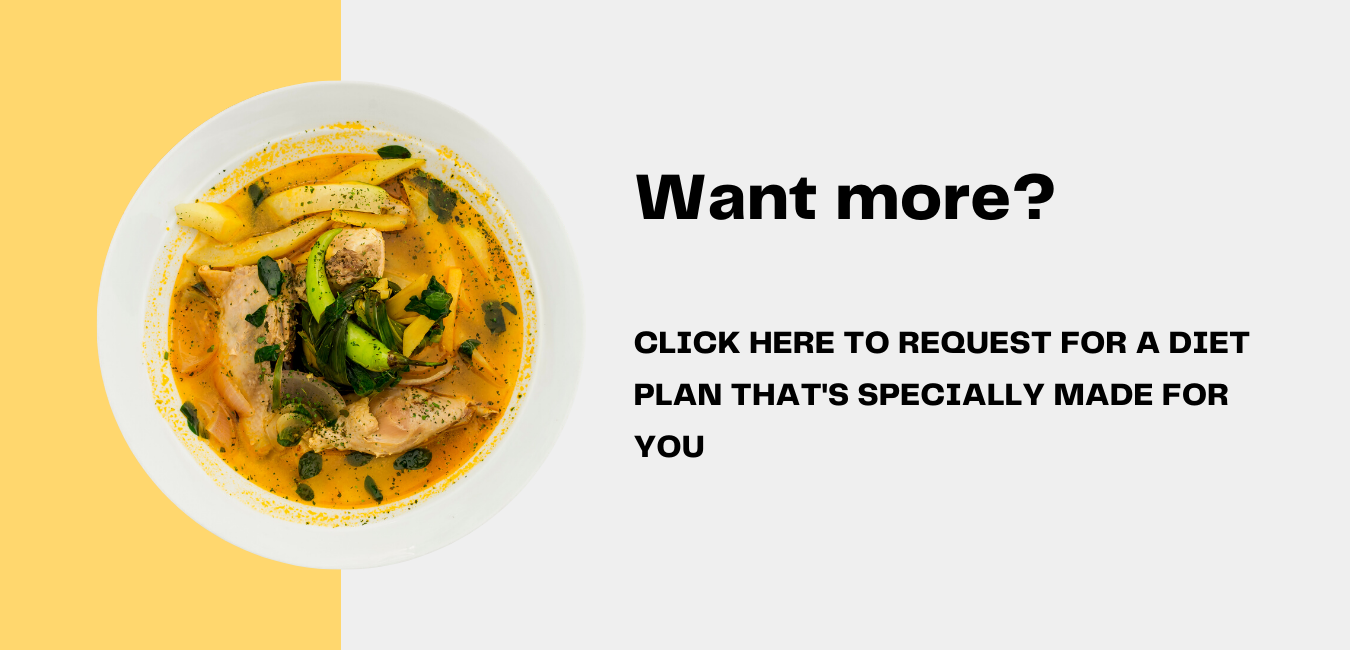
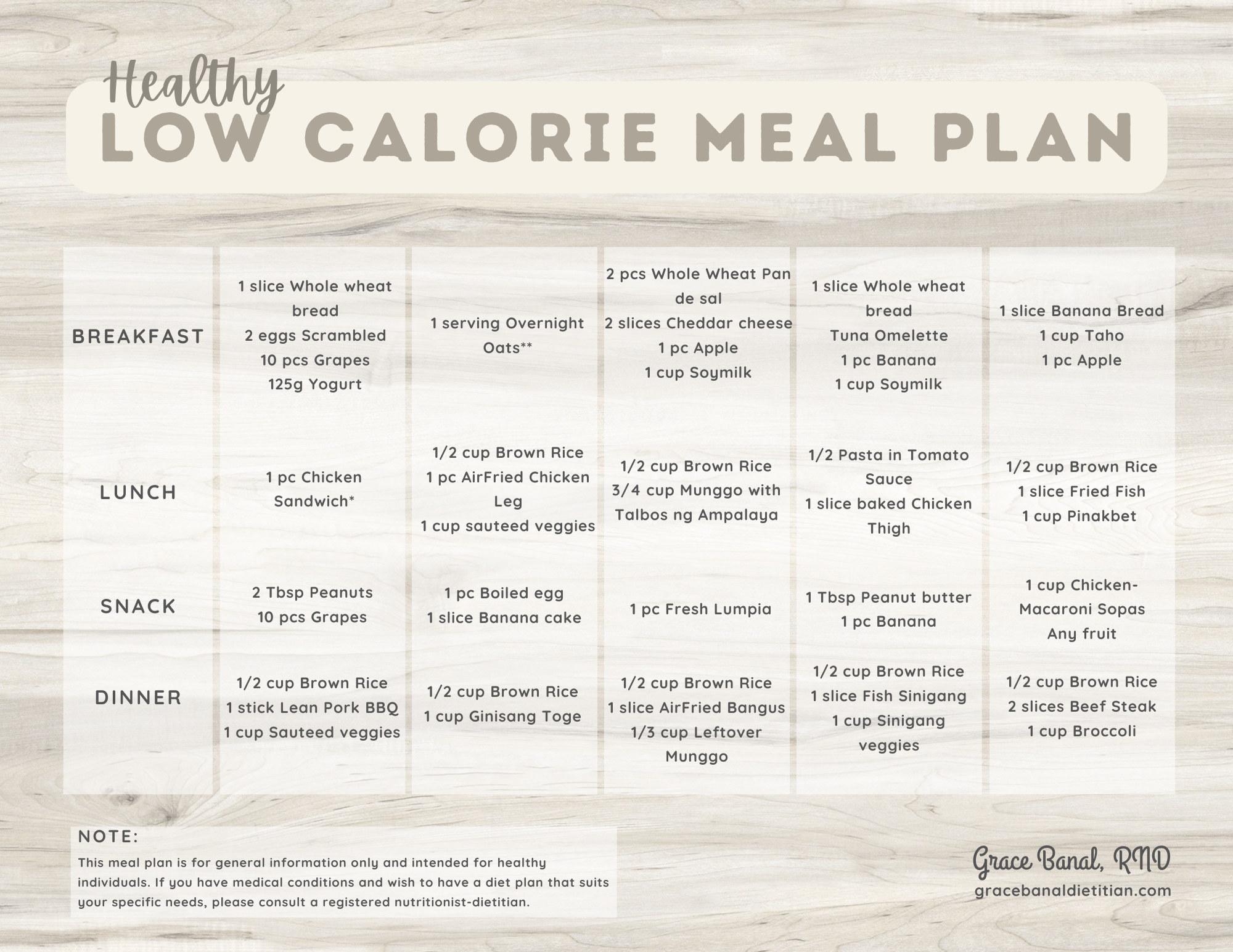
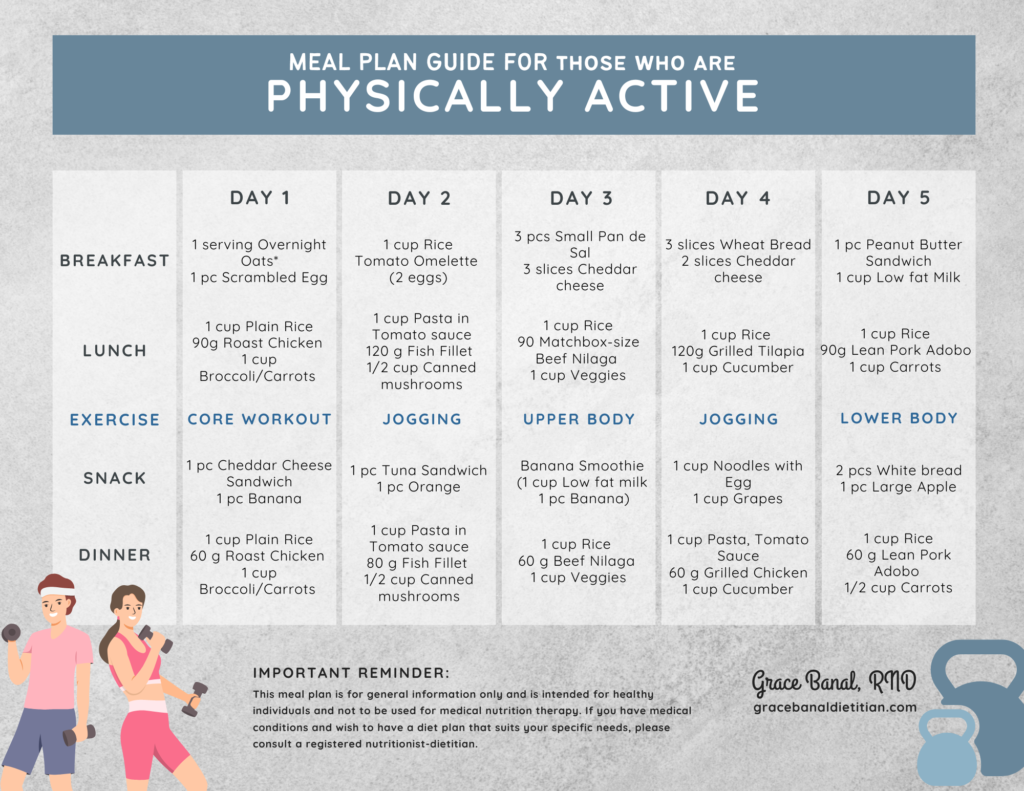
Meal Plan for Physically Active Pinoys
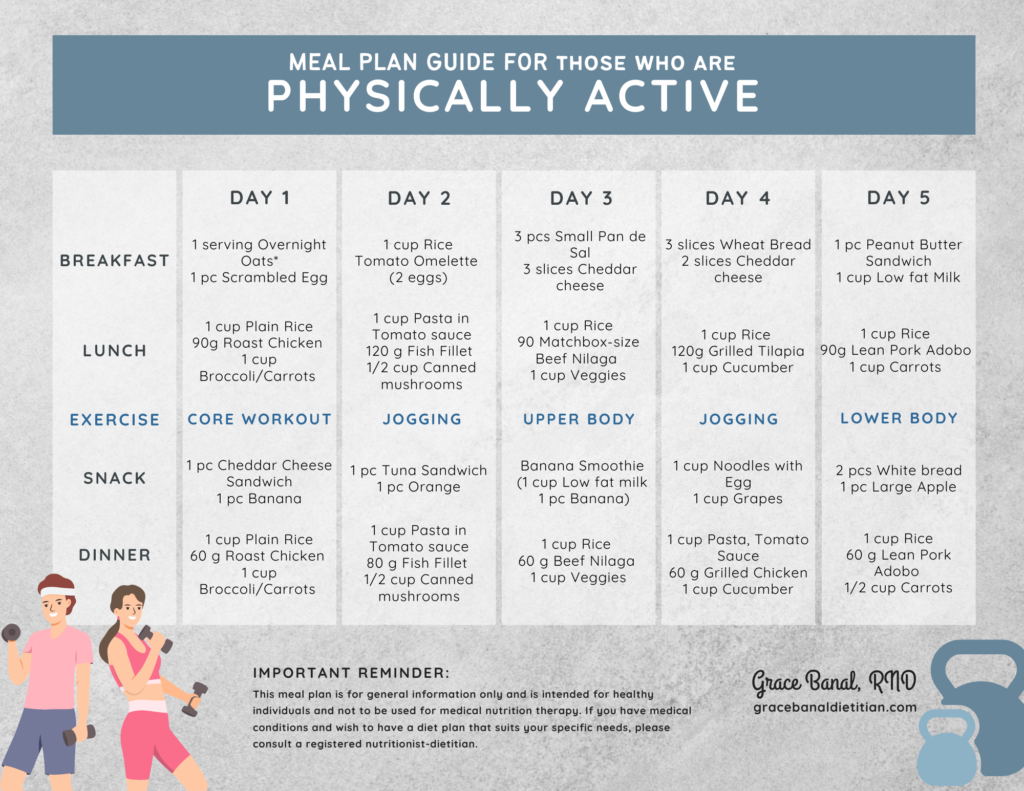
This is a sample meal plan I made for a client who is a young professional working at a corporate office in Manila.
He has just started getting back to his workout routine but he finds it challenging to keep his energy levels up during his training sessions.
Based on our nutrition assessment, he was undereating. This is probably the reason why he doesn’t find consistency in his workouts because he often feels exhausted at work during his training days.
So, we created his meal plan in such as way that he gets enough energy to sustain his training.
If you noticed, food at lunch are also the same for dinner. This is because he can only find time to cook one dish a day as he is busy with work and commute. So in this meal plan, he only needs to cook one dish and have them for both lunch and dinner. He eats outside sometimes but still refers to the meal plan to guide him on what to order.
He was able to sustain his training during the entire program and was happy to tell me that he felt improvement in his training performance, felt more energized at work, and cooking once a day worked for him.
He said it’s a bout time for him to learn this “adulting” stuff.
He was just 23 years old and living independently.
Important reminder:
This meal plan was made for a generally healthy individual. If you have certain disease conditions or not aware of your current nutritional status, please consult a nutritionist-dietitian before following a certain dietary regimen.
If you want to have a meal plan specially designed for you, feel free to book a consultation with me.
Cheers to being stronger this 2023.
Low Calorie Diet

This diet is set at around 1200 calories. This is usually recommended if:
- You are trying to jump-start your weight loss
- You are living a sedentary lifestyle – mostly sitting with no exercise / minimal physical activity
- You have a moderate appetite and can tolerate small meals throughout the day
Please note that in a low calorie diet, micronutrients may be lacking. It may help if multivitamin supplements are taken while in this diet.
*Chicken sandwich:
- 2 slices whole wheat bread
- Leftover roast chicken flakes
- Tomato, lettuce, cucumber
**Overnight oats:
- 30 grams rolled oats (about 1 sachet or 5 Tbsp)
- 1 cup Low fat milk / Soy milk
- Banana slices
- Mix in a mason jar / mug and store in the refrigerator overnight. This will be ready to be eaten the morning after. No need to cook.
Important reminder:
This meal plan was made for generally healthy individuals. If you have certain disease conditions or not aware of your current nutritional status, please consult a nutritionist-dietitian before following a certain dietary regimen.
You may download this meal plan in PDF format here:
Flexitarian Diet
Flex ko lang ang Flexitarian Diet
Flexitarian = Flexible + Vegetarian
It’s a diet that’s primarily vegetarian but allows occasional eating of meat and fish.
It allows you to enjoy the health benefits of vegetarian diet but makes room for animal-based foods since these are good sources of protein, fat and micronutrients as well.
Is it good for the health?
Based on a review of 25 studies on Flexitarian Diet, this diet offers health benefits in relation to:
- Weight loss
- Metabolic health, and
- Diabetes prevention [1].
Is it affordable?
In my opinion, it can be affordable for the typical Filipino budget. Prices of fruits and vegetables have significantly increased over the years and especially during the pandemic, and so are the prices of meats and fishes. If we lessen our budget for meats and increase our budget for plant-based foods, shifting to from meat-based diet to Flexitarian diet will NOT necessarily increase our food expenses.
What foods should I eat more often in a Flexitarian diet?
- Whole grains such as brown/red/black rice, corn, rolled oats
- Root crops and tubers such as potatoes, sweet potatoes, ube
- Nuts, beans, legumes and seeds as main sources of protein
- Fruits and vegetables
- Meat, fish and seafoods that make up only about ¼ of your diet
Potatoes can be easily incorporated in a Flexitarian diet. Curries with Potatoes and Peas as main dish, Cheesy Potato Caldereta where a small amount of meat can be retained, Fries or Baked Potatoes can be eaten during snacks, and Hash Browns for breakfast. Aside from complex carbohydrates, potatoes are good sources of potassium, vitamin C and dietary fiber.
Can we get enough protein when on a Flexitarian diet?
Plant-based foods can be good sources of protein. For example, a medium-sized potato contains about 3 grams of protein. 1 cup of rice contains about 4 grams of protein while vegetables contain about 2 grams of protein per cup. With proper meal planning, it is possible to get adequate protein when on a Flexitarian diet.
Can Filipino foods fit into the Flexitarian diet?
Definitely! There are lots of plant-based options in the Filipino cuisine. I made a very Pinoy Flexitarian Diet and it was one of the easiest meal plan I made.

Do you recommend this diet?
I would recommend this to people who want to lessen their meat intake for health and environmental reasons.
For people with obesity, diabetes, and other disease conditions, please consult a nutritionist-dietitian before following this diet so that you can be guided properly in terms of food quantity, balance and variety.
This post is sponsored by Potatoes USA-Philippines. All opinions are mine.
Reference:
[1] Derbyshire E (2017). Flexitarian Diets and Health: A Review of the Evidence-Based Literature. Frontiers in Nutrition. https://www.ncbi.nlm.nih.gov/pmc/articles/PMC5216044/
*For potato recipes, visit www.potatogoodness.ph.
#potatonutrition #USPotatoPower #potatoesusaphl #potatopower
Meal Plan for Gaining Weight
I didn’t have problems with overweight and obesity because my own struggle actually is in gaining weight. I have always been that “payat” girl in school. While our fat-phobic society favors the slim, I am fully aware of the disadvantages of being underweight and I have also felt the stigma and judgement towards people who are “payat”.
While most of my clients want to lose weight, I also have clients who want to gain weight and I tell you, just as what I have experienced myself – gaining weight is not easy. Just like losing weight, gaining weight also needs a lot of work. Some people think it’s just about “eating more” but it’s more complicated than that.
- How can I eat more when I get busog easily?
- How can I eat more if I’m busy?
- How can I eat more if I don’t have extra money to buy nutrition supplements?
- How can I eat more if food my budget is tight?
I haven’t thought of creating a weight gain meal plan but then I get a lot of messages and comments from my Facebook page asking for a weight gain meal plan so here it is:
Ang weight gain meal plan para sa mga nasa laylayan – a budget-friendly high-calorie sample meal plan.

Tips on how to gain weight (the healthy way):
While it may be tempting to take the “easy” route to weight gain, that is, to eat high-calorie processed foods like pizza, fast foods, processed foods and sugary beverages – as a nutritionist-dietitian I would not recommend that route for obvious reasons.
We want to gain weight but we also want to make sure that we don’t gain an unhealthy lifestyle that would most likely lead us to chronic diseases such as hypertension, heart diseases, diabetes and some forms of cancer. Yes, these diseases can also affect us lean people if we are not careful with what we eat.
So, here are some tips about healthy weight gain that I have learned from experience and from nutrition experts:
Eat 3 meals a day
Skipping meals – breakfast, lunch or dinner – can make you miss out on the calories that these meals provide. Hence, spread out your meals throughout the day to make sure that your meet your total daily calorie requirement.
Add snacks in between meals
Once you have established eating 3 meals a day, it can also be helpful if you add snacks in between meals – morning snack, afternoon snack and/or evening snack to get that calorie surplus we need to gain weight.
Increase calorie content of foods/meals
Add high-calorie food such as oils, nuts. This way, you get more calories with less volume. For example:
- Instead of plain rice, go for fried rice.
- Instead on plain milk shake, add peanut butter or other nut butters to the shake.
- Instead of eating plain bread, add nut butter, olive oil or butter.
- Instead of eating boiled kamote or boiled saba, go for fried or camote/banana cue.
- Add nuts to yogurts, oatmeal or champorado.
- Eat dried fruits such as raisins, prunes, dried mangoes.
- Drink protein-containing high-calorie beverages such as milk and milk shakes.
Do resistance/strength training exercises
When we say we want to gain weight, we often mean we want to gain muscles. Besides, it’s easier to gain weight with muscles because muscles weigh more than fats. So, the best way to gain muscles is through nutrition PLUS resistance training aka weight training aka strength training. Examples are:
- Body weight exercises – push ups, squats, lunges, planks, TRX
- Free-weights – dumbbells, barbells
- Use of equipment such as kettlebells, Vipr, medicine balls, etc
Rest is equally important as exercising when it comes to weight gain because it is during rest that your muscle “builds” from the wear and tear of exercise, provided that you have your nutrition covered.
This is why it’s important to consult a nutritionist-dietitian to determine your individual caloric requirement and macronutrient needs, plus information on how you can work on achieving your specific health goals given the resources you have at the moment.
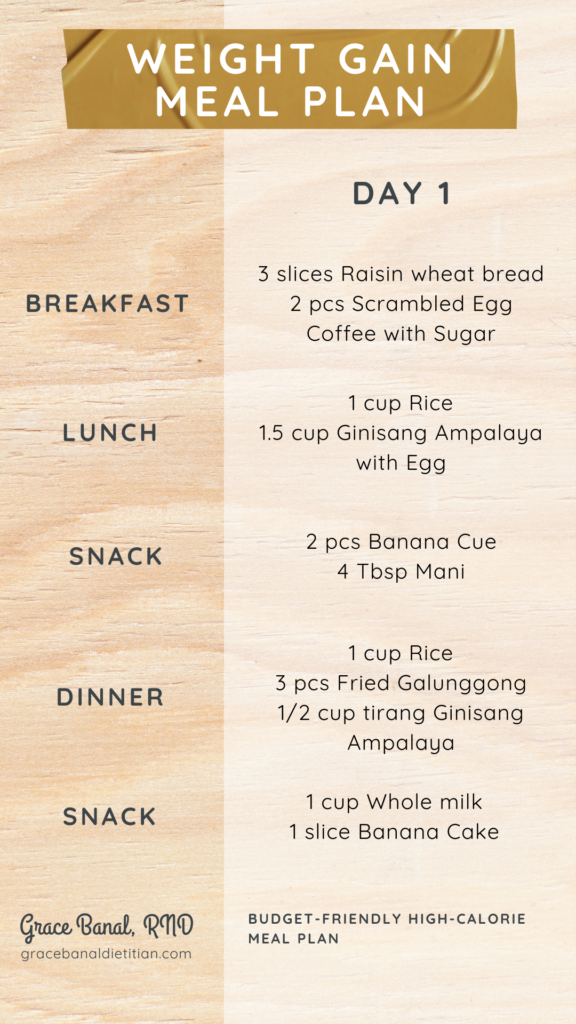
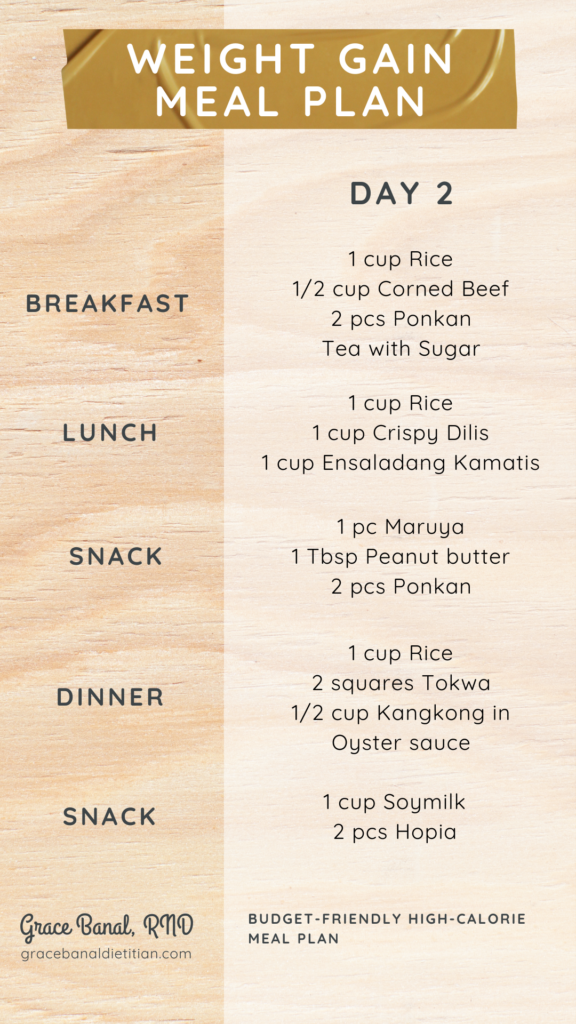
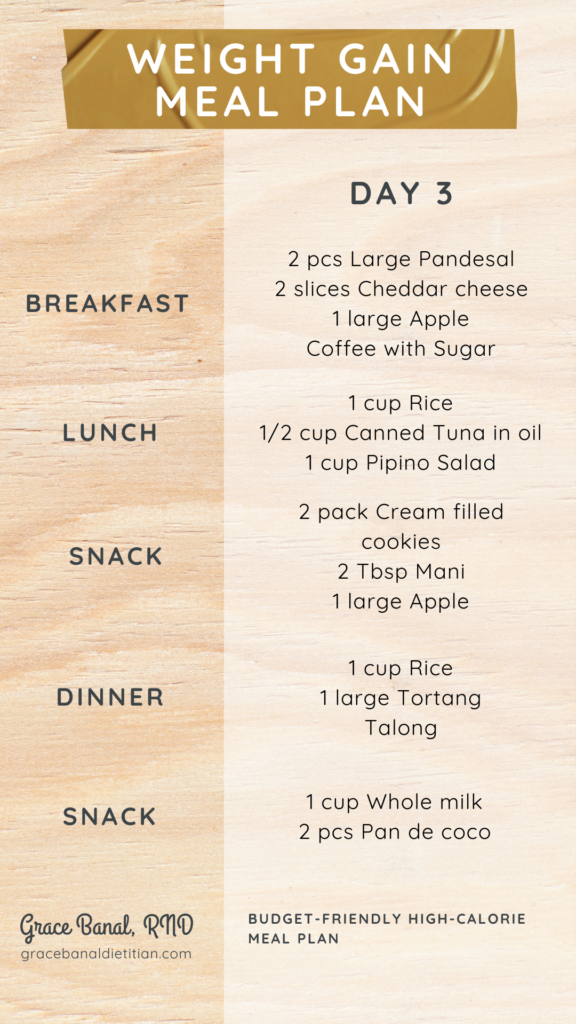
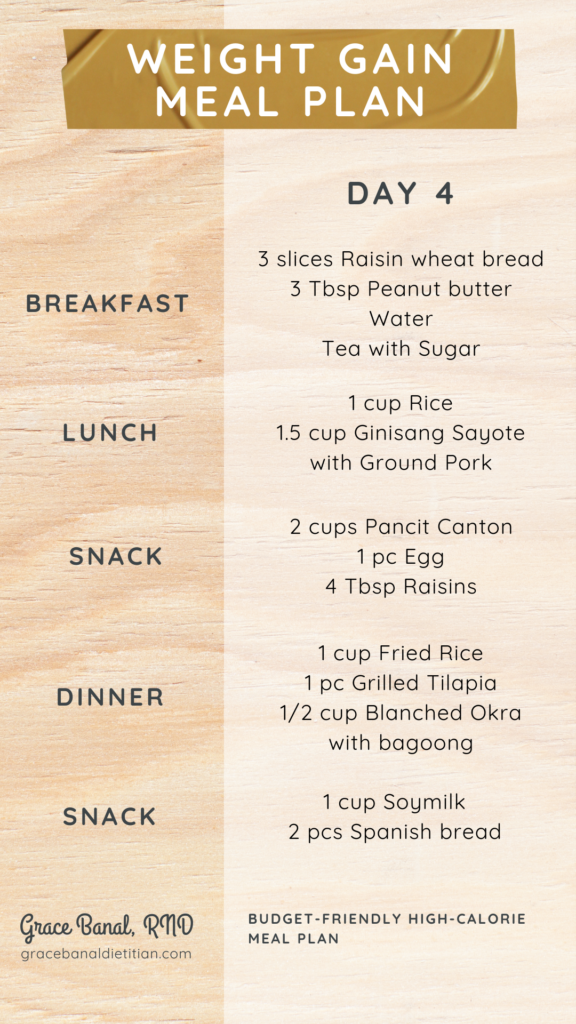

More on BUDGET
To gain weight, we often need to eat MORE which means spending more money on food, which can be a pain in the ass to some, if not most of typical Pinoys (like me :-D). Hence, it is important that we PLAN our meals ahead to be able to maximize our resources which include money, time and effort. Here are my bonus tips:
- Check what’s available in your pantry / fridge first and think of what dishes you can make out of the ingredients you already have
- Plan meals ahead – either 3-day, 5-day or 7-day meal plans
- In meal planning, include meals that utilize affordable ingredients. Feel free to ask for the price list from your suking tindahan to check which food items are offered at low prices. It helps to be updated of the latest prices of foods in the market – these are usually reported in the news or you may check it from the website of the Department of Agriculture.
- Make a grocery/palengke list based on your meal plan.
- Buy fresh produce (fresh meats, fish, chicken, fruits and veggies) from the wet market and non-perishable goods/ingredients from the grocery.
- Pick a palengke suki and huwag mahiyang humingi ng tawad. Don’t expect or feel entitled to discounts, though – the vendors may also be financially struggling so be nice about it.
- Avoid wasting food by checking the expiration dates before buying and storing, and store foods properly (this is another topic).
It may also help if you set a food budget prior to meal planning. Then, compare your actual food expenses to your set food budget and assess if your food budget is realistic.
To help you save time and effort, you can incorporate convenience foods to your meal plan. Add easy-to-prepare and ready-to-eat food items, especially for breakfast and snacks. Examples are canned goods, ready-made sauces, bread slices, sandwiches, instant oatmeals, etc.
I am the one tasked at home to monitor food expenses on top of making sure we sustain a healthy diet for the family so I know the struggle. But, if I was able to rise up from being underweight, got stronger and stayed within food budget while juggling motherhood and career, I believe you can, too.
Kain po!
If I was able to rise up from being underweight, got stronger and stayed within food budget while juggling motherhood and career, I believe you can, too.
Grace Banal, RND
Download the meal plan here:
Please note that this sample meal plan is for general information only and is intended for healthy individuals and not to be used for medical nutrition therapy. If you have medical conditions and wish to have a diet plan that suits your specific needs, please consult a registered nutritionist-dietitian.
If you wish to consult a nutritionist-dietitian, kindly fill up the assessment form and email us at [email protected].
If you wish to contact Grace, please check the Get in touch with me menu.
Diet Para sa Buntis
Bawal mag-“diet” ang mga buntis!
Grace Banal, RND
Pregnancy is NOT the right time to go on a diet – mapa-Ketogenic diet man yan o Intermittent fasting, juicing and other fad diets that promote too much or too little of a certain food or nutrient. This is because being on “a diet” without proper medical supervision may put you and your baby’s risk for malnutrition.
At dahil ang nutrition month theme natin ay nakasentro sa FIRST 1000 days of life – kasama dito ang 270 days of pregnancy, may I present you:
Ang Diet Plan Para sa Buntis
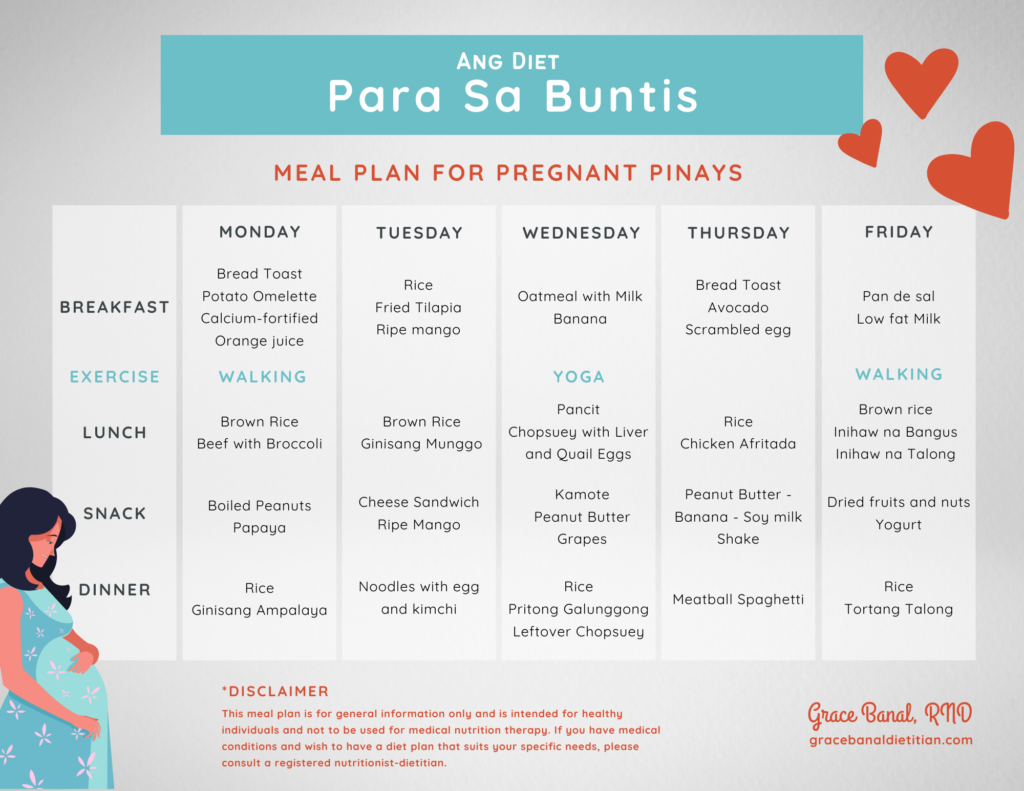
Siyempre 1-week sample meal plan lang ito kaya please keep reading for more tips to guide you on your diet throughout pregnancy.
But before we proceed…
You’re having a baby? Congratulations! And good job for being here because it shows that you are taking steps towards a healthy pregnancy. ?
Now here are my tips on how to have a healthy diet during pregnancy
Eat more of these:
Dark green leafy vegetables
- Malunggay, kangkong, pechay, mustasa, bok choy, dahon ng sili, broccoli, etc
- These foods supply us with dietary folate which is essential for the development of baby’s brain and nervous system. A diet lacking in folate may lead to neural tube defects in infants.
- Pregnant women (Filipinos) need about 600 mg dietary folate equivalent per day.
- Other sources of folate include legumes and liver
Red meat, fish, chicken
- These foods are rich in iron. We need iron to make hemoglobin, a molecule in the blood that carries oxygen to cells throughout your body and to your growing baby
- Having enough iron in your diet may help prevent anemia. Symptoms of anemia include tiredness, weakness, dizziness and shortness of breath (hinahapo).
- Pregnant women are recommended to get 38mg iron from diet everyday. This might be difficult to achieve from foods alone so iron (and folate) supplement is recommended. Please consult your doctor before taking any prenatal supplement.
- Other sources of iron include legumes, dried fruits and iron-fortified cereals.
Fresh fruits and vegetables
- Citrus fruits such as guava, mango, pineapple and other fruits such as strawberries are rich in vitamin C
- Red and Green bell peppers are very high in vitamin C
- Potatoes and broccoli are also good sources of vitamin C
- These foods complement iron-rich foods – Vitamin C in fresh fruits and vegetables help your body absorb iron from your diet
- Vitamin C also helps maintain a healthy immune system which is very important during pregnancy.
- Pregnant women are recommended to get 70 mg Vitamin C per day from their diet
- For more information about Vitamin C, please check my FB post here.
Beans, nuts and seeds
- Munggo, bitsuelas, patani, buto ng sitaw, bataw, soybeans, garbanzos, green peas
- Mani, kasuy, pistachio, almonds, pecan nuts, macadamia nuts, butong pakwan, buto ng sunflower
- These are excellent sources of calcium which helps pregnant moms maintain healthy bones and teeth. Calcium also helps prevent rickets (soft bones in infants/children).
- Pregnant moms are advised to aim for 800 – 850 mg Calcium from their diet
- Other sources of calcium are milk and dairy products, small fishes with bones, green leafy vegetables, and calcium fortified soy milk / orange juice.
Avoid / Limit these:
Alcohol
- Beer, gin, wine, vodka, brandy, rum, soju, tequila, whisky etc
- Please avoid drinking alcoholic beverages during pregnancy (or even if you’re just trying to get pregnant). Alcohol intake has been linked to preterm delivery, miscarriage and may affect baby’s brain and heart development
Caffeine
- Coffee, tea, energy drinks that contain caffeine
- Caffeine intake may affect the baby’s heart rate and breathing
Raw foods and foods that are not properly cooked / prepared
- Food safety is very important especially for pregnant mothers to avoid food poisoning from Salmonella, E. coli, norovirus, botulism etc.
- Food poisoning may cause diarrhea and vomiting which may lead to nutrient loss and hospitalizations.
- Avoid food contamination by separating raw foods from cooked foods and make sure that eggs, chicken and other meats are cooked properly.
- Avoid overcooking your vegetables, though. Just make sure that fresh fruits and vegetables and root crops are washed and cleaned thoroughly.
Other considerations:
Calories
- It’s not true that pregnant women should “eat for two”. This may lead to excessive consumption of calories. Too much calories in the diet can cause excessive weight gain. This can put you at higher risk for hypertension, gestational diabetes and Cesarean section.
- You have to eat just enough calories to achieve and maintain a healthy weight gain.
- To know more about healthy weight gain during pregnancy, please consult your doctor. To know how much calories, carbohydrates, protein and fat you need and to help you plan your meals for healthy weight gain during pregnancy, please consult a licensed nutritionist-dietitian.
Exercise
- Pregnant women are encouraged to engage in regular moderate physical activity.
- This prevents excessive weight gain and improves sleep
- Regular exercise also minimizes back pain, swelling and constipation among pregnant women
- Please consult your doctor before starting any exercise regimen during pregnancy
- Recommended physical activities are walking, brisk walking, swimming, elliptical machine, and light resistance training. If you find it difficult to carry on a conversation during your exercise, it means that the exercise may be too intense for you.
- Avoid jumping and other jerky/bouncy movements. Avoid exercises that require you to lie on your back or where you may be hit in the belly
- Avoid exercising in a very hot environment
- Stop exercising if you feel chest pains, bleeding, outflow of amniotic fluid, abdominal plain or uterine contractions
Please talk to your OB-GYN before following any diet and exercise regimen and/or taking dietary supplements. For more information about nutrition during pregnancy, please consult a licensed nutritionist-dietitian.
Download this diet guide here:
Please note that this sample meal plan is for general information only and is intended for healthy individuals and not to be used for medical nutrition therapy. If you have medical conditions and wish to have a diet plan that suits your specific needs, please consult a registered nutritionist-dietitian.
If you wish to consult a nutritionist-dietitian, kindly fill up the assessment form and email us at [email protected].
If you wish to contact Grace, please check the Get in touch with me menu.
References / Additional reading:
DOST-FNRI. Philippine Dietary Reference Intakes 2015. https://www.fnri.dost.gov.ph/index.php/tools-and-standard/philippine-dietary-reference-intakes-pdri
Centers for Disease Control and Prevention. Get Active! April 24, 2018. https://www.cdc.gov/diabetes/managing/active.html
Exercise during pregnancy. September 2020. https://www.marchofdimes.org/pregnancy/exercise-during-pregnancy.aspx
Gotsclich, M. M. (2007). The ASPEN Nutrition Core Curriculum: A Case-Based Apporach – The Adult Patient. ASPEN.
Majella, M. G., Sarveswaran, G., Khrishnamoorthy, Y., Arikrishnan, K., & Kumar, S. (2019). A longitudinal study on high risk pregnancy and its outcome among antenatal women attending rural primary health centre in Puducherry, South India. Journal of Educ Health Promotion.
Ross, C., Caballero, B., Cousins, R., Tucker, K., & Ziegler, T. (2014). Obesity: Epidemiology, Etiology and Prevention. In A. Ross, B. Caballero, R. Cousins, C. Tucker, & T. Ziegler (Eds.), Modern Nutrition in Health and Disease (11th ed.). Baltimore, MD: Lippincott Williams and Wilkins.
Stoggianni, A., Lendahls, L., & Thunander, M. (2019). Obstetric and perinatal outcomes in pregnancies complicated by diabetes, and control pregnancies, in Kronoberg, Sweden. BMC Pregnancy and Childbirth.
Ang Diet para sa PUSO Mo
Alam nyo ba na ang mga taong may
- high blood pressure
- hypertension
- high cholesterol
- diabetes
- obesity
ay may mas malaking chance magkaroon ng cardiovascular disease, aka heart disease in the future?
At para sa araw ng mga puso, may I present you the “Ang Diet Para sa Puso Mo” – a heart-healthy meal plan. ❤️?

⚠️ A diet high in sodium and processed foods, added sugars, unhealthy fats and a diet that lacks fruits and vegetables, whole grains, fiber, legumes, fish, and nuts has been associated with the development of heart disease.
✅ On the other hand, numerous scientific studies report that a healthy diet plays an important part in preventing the development of heart disease by helping you manage your weight and/or prevent or manage hypertension, diabetes, or dyslipidemia.
When it comes to heart health, latest scientific studies and expert guidelines recommend the following diets:
But when you look for these diets online, references often feature Western foods such as olive oil, salmon, salads, etc which are beyond the typical Pinoy’s taste or budget.
So how can we make a heart-healthy diet plan that’s Pinoy-friendly? Here’s what I got for you:
A Pinoy heart healthy diet means eating MORE of these:
✅Plant-based foods:
- Fruits and vegetables – kahit anong prutas at gulay, go lang.
- Whole grains – brown/red/black rice, corn, oats, whole wheat cereals and whole wheat breads
- Nuts – peanuts, almonds, kasuy etc
- These foods are good sources of fiber, vitamins, minerals, phytochemicals/antioxidants and omega 3 fatty acids (healthy fats) that help prevent the development of heart disease.
✅Animal foods:
- Chicken (except chicken skin) and any type of fish.
- Chicken and fish are good sources of protein, vitamins and minerals and contain less saturated fat compared to pork/beef/lamb.
- Fatty fishes such as tuna (other locally-available fishes) are also good sources of omega 3 fatty acids – the kind of fat that’s good for the heart and brain.
✅ Healthy oils:
- Canola oil, corn oil, avocado, peanut butter, olive oil
A Pinoy heart-healthy diet also means eating LESS of these:
- Processed meats such as hotdogs, bacon, longganisa, burger patties, pork tocino etc
- Salty foods due to excessive use of salt, patis, toyo, bagoong, broth cubes etc
- Pork, beef, lamb and butter
- Margarine, fast foods, chips, doughnuts and other pastries
- Refined carbohydrates such as cookies and pastries, sugary beverages, ice cream etc
- These foods contain high amounts of sodium, saturated fats, trans fats and simple sugars that put you at higher risk of developing heart diseases.
In summary, a heart-healthy diet is high in fiber, vitamins, minerals and low in cholesterol, saturated fat and trans fats.
But remember, following a heart healthy diet for a week is not enough. It takes time – a long time – for us to reap the benefits of a healthy diet. Therefore, let’s work on making these dietary changes into LASTING food habits.
Also, please take note that
? Getting old? Gender ? Genetics
also increase our chances of having heart disease.
There’s nothing we can do about these so let’s focus on the things that we can do and we can control:
✅ Do not smoke✅ Maintain a healthy weight✅ Be physically active
✅ Have a heart-healthy diet
Happy hearts day!
References / Additional readings:
https://www.ncbi.nlm.nih.gov/pmc/articles/PMC6320919/
https://www.ncbi.nlm.nih.gov/pmc/articles/PMC6320919/
https://www.nhlbi.nih.gov/health-topics/dash-eating-plan
https://www.nhs.uk/live-well/eat-well/what-is-a-mediterranean-diet/
Please note that this meal plan is for general information only and is intended for healthy individuals and not to be used for medical nutrition therapy. If you have medical conditions and wish to have a diet plan that suits your specific needs, please consult a registered nutritionist-dietitian.
If you wish to consult a nutritionist-dietitian, kindly fill up the assessment form and email us at [email protected].
If you wish to contact Grace, please check the Get in touch with me menu.
Download this diet guide here:
The Tamang Healthy Lang Diet Guide

About this Diet Guide
This diet guide is set at approximately 2000 calories per day. This is suitable for those who have average height and built and with moderately active lifestyles who wish to maintain weight.
In my experience, most clients would say “these foods look a lot!”. Yes, it does look a lot on paper but in real-life (aka in your plate), it looks pretty normal.
Also, they look a lot because this diet guide is built upon the context that most meals are prepared at home with whole foods as ingredients. When eating out in restaurants or fast foods, meals may have bigger portion sizes. Hence, be mindful of the portion sizes indicated in this guide.
I call this “healthy” because it includes 4 servings of vegetables and 4 servings of fruits. These foods are rich in fiber, vitamin C, potassium, folate, phytochemicals and other vitamins and minerals which may help prevent lifestyle diseases such as heart disease, diabetes and obesity.
It is set at about 55-60% carbohydrates, 15% protein and 30% fat, which falls within the Acceptable Macronutrient Distribution Range (AMDR) by the Philippine Dietary Reference Intakes 2015.
Please take note that these diet guides are for education / information purposes only. Your calorie and nutrient needs may vary depending on A LOT of factors. Please consult a licensed health professional before starting a diet or exercise regimen.
If you wish to consult a nutritionist-dietitian, kindly fill up the assessment form and email us at [email protected].
If you wish to contact Grace, please check the Get in touch with me menu.
Download this diet guide here:
References:
Philippine Dietary Reference Intakes (PDRI). (n.d.). Retrieved from Food and Nutrition Research Institiute: www.fnri.dost.gov.ph/index.php/tools-and-standard/philippine-dietary-reference-intakes-pdri
The Magda-Diet na talaga ako this 2021 Diet Guide
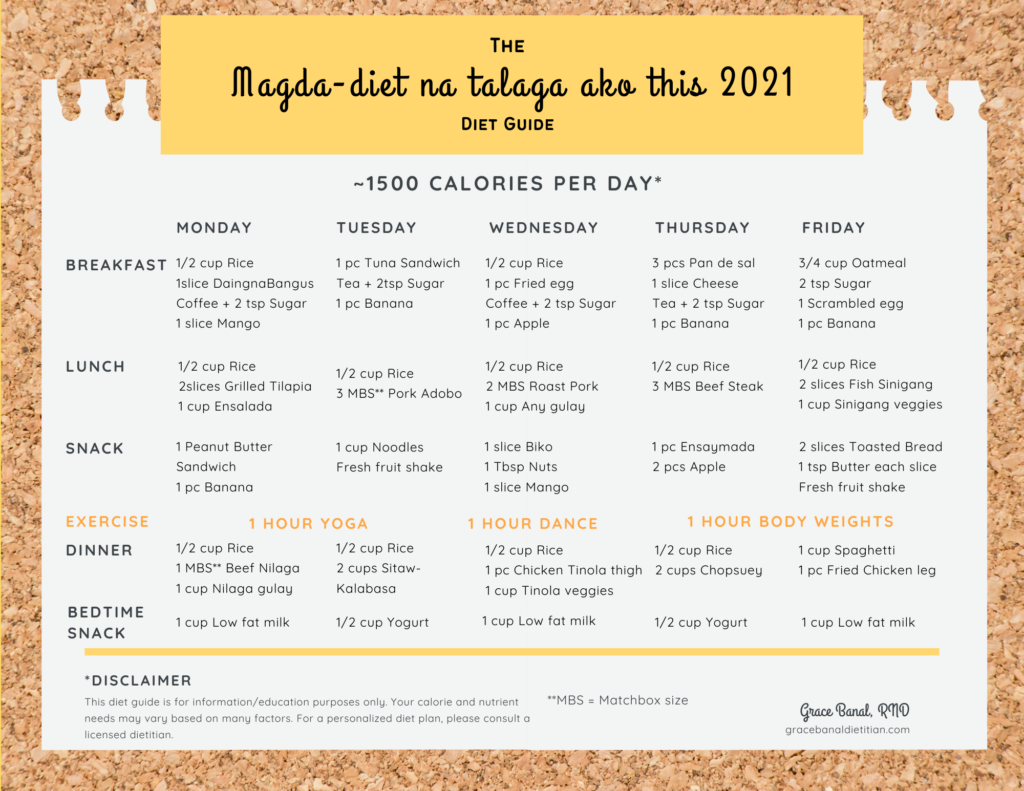
About this Diet Guide
I created this diet plan for a client with a BMI of 30 who is generally healthy (meaning, walang diabetes, hypertension, o kung ano mang iba pang sakit). Based on our assessment, she needs about 1500 calories a day coupled with exercise to help her lose weight.
If you are thinking about changing your diet to help you lose weight, here are some additional tips for you:
- The total calories from the food you eat should be less than the amount of calories you spend through physical activity. This sample diet plan is set on 1500 calories per day which was computed to be just enough for this particular client who also plans to do at least 150 minutes of exercise each week. Don’t set calorie targets that are too low because this can lead to nutrient deficiencies = sickness = plans derailed.
- Small but frequent meals can help with hunger management (no pun intended :-). Problems with “dieting” include hunger pangs and cravings. So, to control you hunger without going overboard with calories, aim for at least 3 small meals and a snack as opposed to one-time big-time. This strategy can also help with managing blood sugar for those who have or at-risk for diabetes. In this diet guide, you can see that 1500 calories is spread throughout the waking hours in 3 meals and 1 snack.
- Another way to control hunger and prolong satiety (feeling full for longer) is to include protein-rich or high-fiber foods in each meal. This way, you can avoid unnecessary cravings and therefore allows you to avoid eating high-calorie foods. In this diet guide, each meal contains either a protein-rich food (meat, fish or chicken) or high-fiber vegetables/fruits (or both).
- When looking for diet guides, make sure that you consider your food preferences, budget, physical activity, even religion or culture. This helps you adhere to the diet plan for a longer period of time. In this diet guide, the client was asked of her preferred foods and we picked most of those that are low in calories but we also included a fast-food meal because she said that she gets busy and eats out on Friday afternoons.
Remember, weight loss for good is a marathon, not a sprint. If you want to achieve a true weight loss, you have to build on habits that you can stick with for the long run. Having a diet plan that is easy to follow can help you avoid weight ups and downs and build sustainable eating habits that you can maintain long enough until you see improvements in weight and in your overall health.
For more information about weight loss, please read these:
The 7 Habits of Highly Effective Dieters
Very Low-Carb Diets: Dapat ba akong maki-uso?
Gaano kadami ang pwede mong ma-lose na timbang sa isang linggo?
Download this diet guide here:
Please take note that these diet guides are for education / information purposes only. Your calorie and nutrient needs may vary depending on A LOT of factors. Please consult a licensed health professional before starting a diet or exercise regimen.
If you wish to consult a nutritionist-dietitian, kindly fill up the assessment form and email us at [email protected].
If you wish to contact Grace, please check the Get in touch with me menu.
A Diet Plan for Every Juan
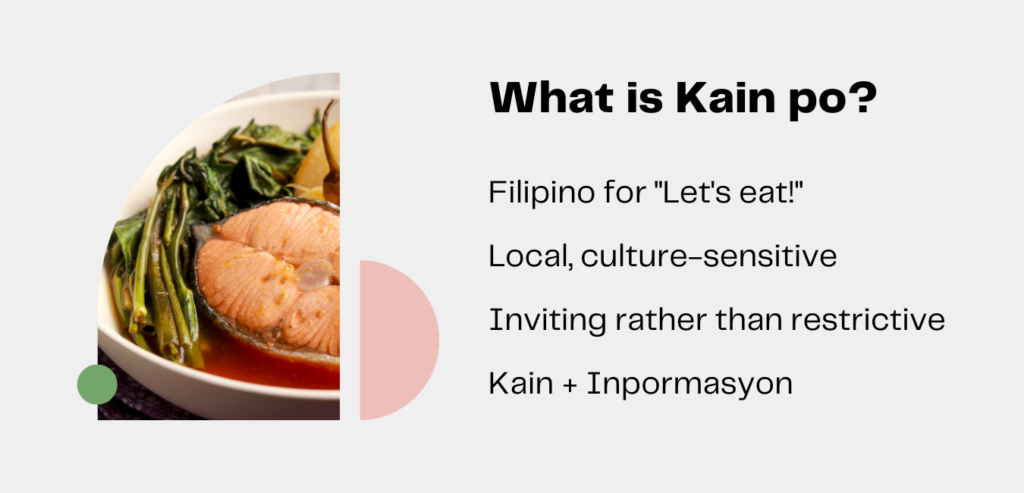
In Filipino, Kain po means “Let’s eat!”
We aim to share culture-sensitive diet plans that utilize Filipino foods and locally-available ingredients.
We invite fellow Filipinos to eat more healthy foods rather than put them on a restrictive diet.
Here, diet plans are complemented with additional nutrition information that are relevant and accurate.
If you wish to have a meal plan specially made for you, please check our services here.
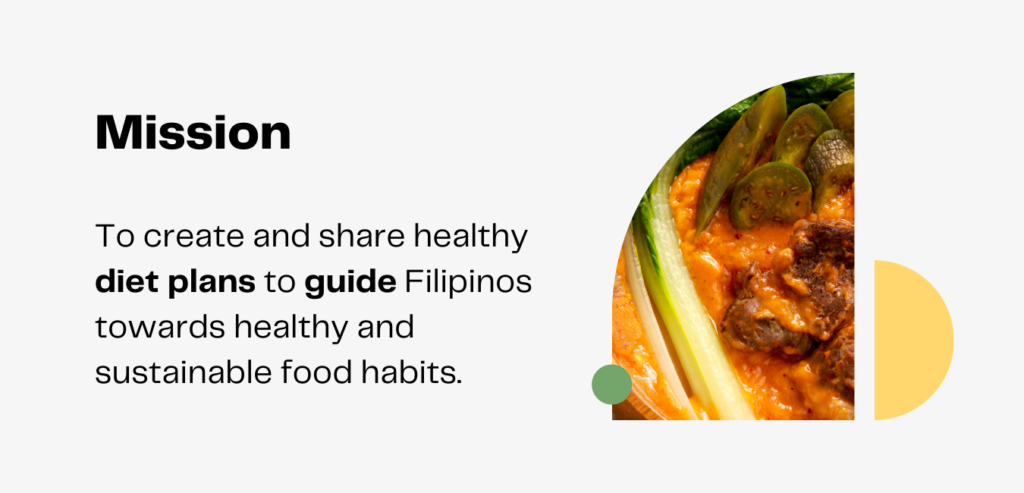
Mission
To create and share healthy diet plans Filipinos can actually follow and use to guide them towards healthy and sustainable food habits.
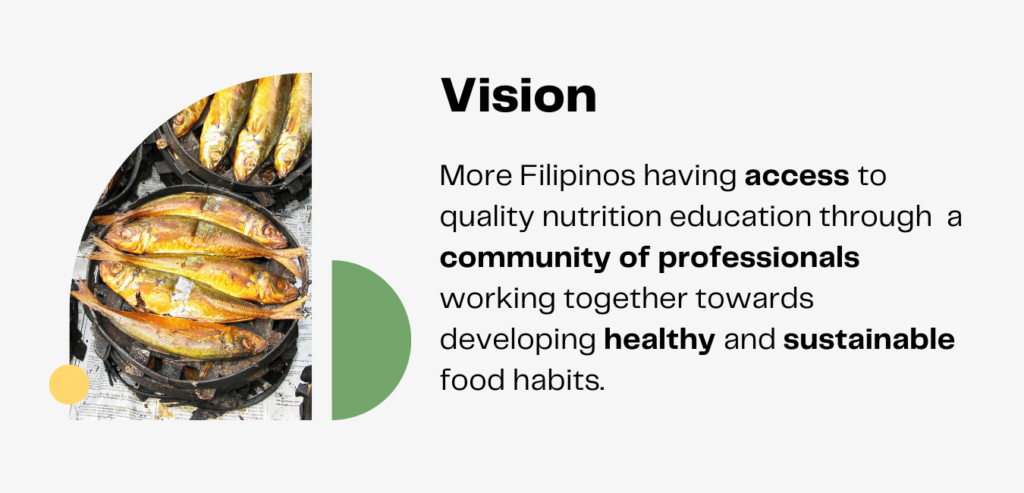
Vision
More Filipinos having access to quality nutrition education through a network of dietitians, fitness professionals and other individuals working together towards developing healthy and sustainable food habits.

In time, Kain Po aims to build a library of downloadable meal plans to help Filipinos make appropriate food choices coupled with additional nutrition-related information from professionals.
Please keep in mind that the diet plans in this website are for information purposes only.
Your calorie and nutrient needs may vary depending on may factors such as your height, age, physical activity, lab results and existing medical conditions. We also make take into consideration your food preferences, schedule, budget, religion and other factors in creating diet plans. Hence, we encourage you not to rely on these diet plans and seek the advice of licensed nutritionist-dietitians for specific nutrition recommendations.
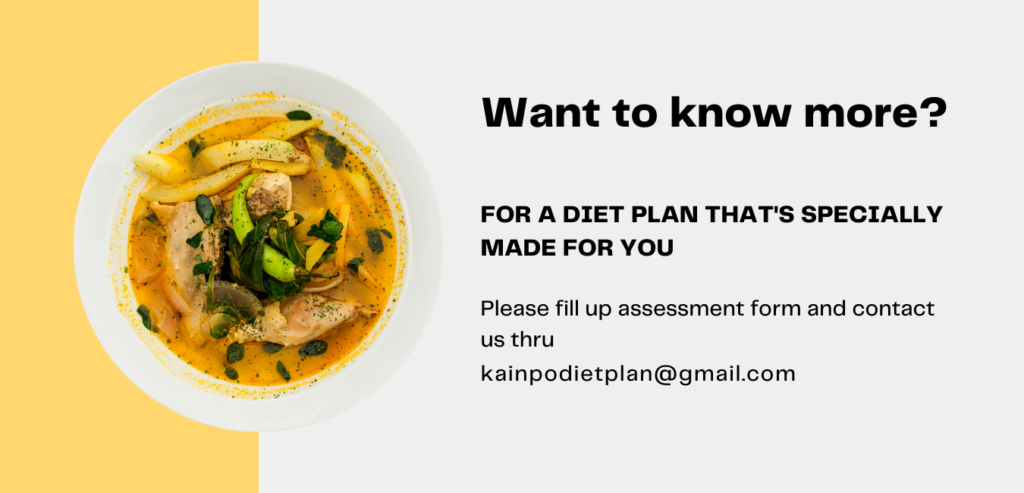
If you wish to contact Grace Banal, please check the Get in touch with me menu.
Thank you and have a great day!
Have patience with all things, but first of all with yourself.
Saint Francis de Sales

